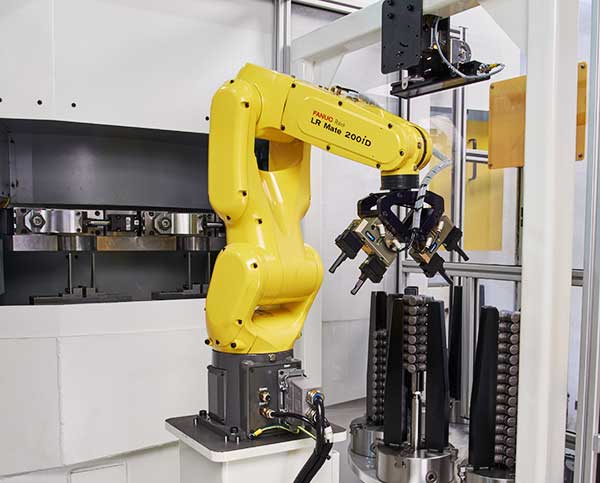
One-two productivity punch: Rotary transfer systems with robotic automation
If you’re looking for a way to improve cycle time and reduce throughput variations on your critical production lines, why not replace your existing pick-and-place production system with robotic loading and unloading of your rotary transfer tools?
Eliminating the manual transfer of parts between a succession of stand-alone machines can improve your overall part quality. It also reduces variability in cycle times and cost per part.

Robotic automation takes over the role traditionally performed by a human machine tender. Like any human operator, the machine tender may become fatigued over time and requires periodic breaks. In short, the operator controls the cycle of the machine. That can lead to significant variations in throughput and productivity, as well as frequent interruptions to production processes.
Another reason to replace the human machine tender with robotic automation has to do with demographic trends. Many manufacturers are already experiencing labor shortages; the Association of Manufacturing Technology (AMT) urges OEMs to fully automate their production lines by 2025 – which is only four years away! A lack of trained production line workers can seriously hamper your ability to produce the large quantities of high-quality parts your customers require.
Benefits of robotic machine tending
Utilizing a robot as a machine tender enables you to automate the process of putting and removing parts from rotary transfer machine tools. This leads to more consistent cycle times, improved part quality and higher overall productivity. It also reduces labor costs.
If the production line has a fairly fast cycle time requirement, one robot can tend one rotary transfer tool. In applications where cycle times may be slower, one robot can tend several machines. It can also be used to inspect and clean parts. In addition, robots can work reliably in lights-out, automated production environments, which are becoming more common today.
Today’s collaborative robots can be easily programmed to perform a variety of tasks, making them flexible players in today’s automated manufacturing environments. They can be placed in a dedicated machine tending role on a high-production, long-run line. But they can also be reprogrammed as needed for low-production applications with no loss in efficiency.
The Kaufman advantage
Where can you find machine tooling and automation expertise under one roof? At Kaufman Manufacturing. We have been building and supporting machine tools for high-production manufacturing environments for over 90 years. In addition, we offer significant expertise in programming, installing and supporting robotic automation systems.
This enables us to provide you with a turnkey solution to automated manufacturing. It enables you to single-source both of these technologies. That, in turn, can help you simplify the setup and maintenance of your critical parts manufacturing operations.

